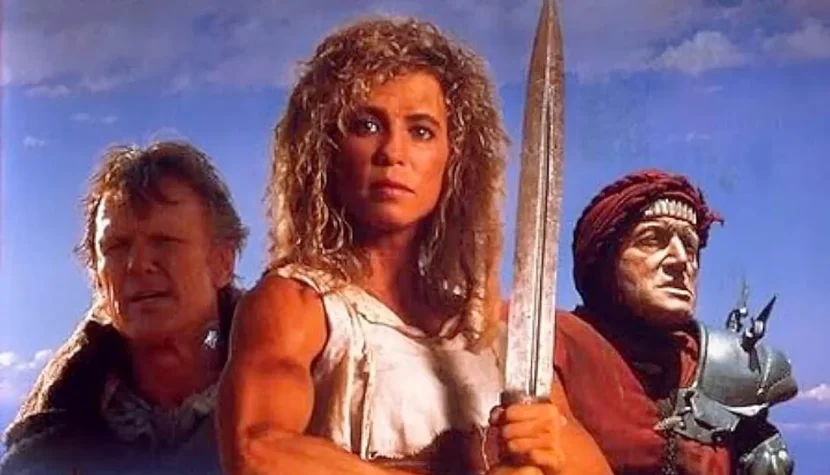KNIGHTS. Science fiction about cyborgs in the best, cheap style

When writing in the title about a cheap style, I had budget in mind, as can be seen in the special effects, cinematography, and music. However, the story crafted in “Knights” is unique, which makes it valuable. The script was written by director Albert Pyun, drawing from the best genre conventions available to him in the early ’90s. Thus, he was mainly inspired by sci-fi films made in the ’70s and ’80s. However, he added western and knightly elements to the classic vision of robot battles in a post-apocalyptic setting. “Knights” is, therefore, to some extent, a futuristic epic, a synthesis of science fiction, fantasy, road movies, and vampire horror. That’s why, despite its low budget and terrible sound design, it cannot be ignored in the history of the sci-fi genre. On the contrary, we must ensure it’s not forgotten—though it is almost unknown to younger generations. Proof of this is the 2,200 ratings on IMDb. The world is slowly erasing Albert Pyun’s works from cinematic history, and I don’t intend to let that happen.
“Knights” is based on a classic premise of post-apocalyptic science fiction: human civilization has been destroyed. The apocalypse of the human race was triggered by a conflict between a mysterious creator of cyborgs and his creations, who rebelled against him. It’s not stated how they came to dominate the world, but a long and exhausting conflict clearly broke out, devastating both sides, as few cyborgs survived as well. Their commander, a certain Job (played by Lance Henriksen), has about 20 artificial warriors under his command. Over time, they also faced a power supply problem. However, the cyborgs solved this by adapting their mechanisms to draw energy from human blood. Interestingly, some humans serve them, not caring that the cyborgs have only one goal: to breed humans as slaves to harvest their life force. However, even in such dark times, a “good” cyborg emerges, one who hasn’t been turned into a vampire—Gabriel, played by Kris Kristofferson. He is accompanied by Kathy Long as the human warrior Nea. Gabriel aims to carry out a program to restore order on Earth, which will allow humanity to rebuild civilization. Nea, on the other hand, kills cyborgs for revenge because Job murdered her parents years ago.

As you can see, there is nothing groundbreaking in this plot, except perhaps how the cyborgs “eat.” They do so by using two needles attached to one of their arms, which they use to suck blood from humans. They can either fully or partially drain their victims. However, animal blood doesn’t provide them with as much energy, so they can only drink it to survive for a limited time. “Knights” captivates not only because of this peculiar vision of cyborgs. Despite the low budget, the creators made sure to design good fight scenes. There are plenty of them. The actors and stuntmen don’t hesitate to make contact with each other. The blows hit the opponents, rather than missing them as in many contemporary productions with Steven Seagal. There is constant jumping, impressive falls, and Nea efficiently kills cyborg after cyborg because she knows their weak point: the center of the forehead. However, Job is the creepiest character. The casting of Henriksen was the best possible choice. Even his red outfit and modified arm with a hook-like finger indicate that he is the leader. However, the problem for the heroes is that he supposedly serves someone even more powerful. And here, we find room for a twist, and possibly a continuation, which should unfold in the mysterious cyborg city ruled by the Great Builder. The movie doesn’t even last 90 minutes, so there was potentially time to shoot the final showdown. For some reason, Albert Pyun chose not to do so. I don’t think it was due to a lack of ideas but rather costs. The filming was rushed, and the crew was watching every dollar. However, delaying the continuation of the story for a better time isn’t a good idea, especially in low-budget cinema. A few years later, Albert Pyun returned to the cyborg post-apocalypse and made “Omega Doom”.

“Knights” is a film for seasoned sci-fi fans who are immune to practical effects, many editing shortcuts, scenes shot at most twice because there’s no more time, sometimes even dialogue errors, actors’ slips, and the rich, almost baroque soundtrack composed by a fan of electronic music. Aside from the intense fight sequences, Pyun’s film also reflects on the existential problems of cyborgs. They are well aware that they are not alive, that death is an unknown experience for them. This is particularly felt by the monstrous Job. At times, he imagines himself as a prophet. He wants to be second only to his creator god in the Cyborg City. However, at the moment of his death, just before he “ceases functioning,” he delights in enriching his synthetic life, which no one wanted to call a true existence, with something real—death. For this scene alone, and for Lance Henriksen’s intense presence, “Knights” is worth watching.

